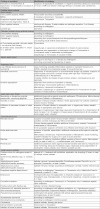Supportive therapy in medical therapy of head and neck tumors
- PMID: 23320053
- PMCID: PMC3544209
- DOI: 10.3205/cto000083
Supportive therapy in medical therapy of head and neck tumors
Abstract
Fever during neutropenia may be a symptom of severe life threatening infection, which must be treated immediately with antibiotics. If signs of infection persist, therapy must be modified. Diagnostic measures should not delay treatment. If the risk of febrile neutropenia after chemotherapy is ≥20%, then prophylactic therapy with G-CSF is standard of care. After protocols with a risk of febrile neutropenia of 10-20%, G-CSF is necessary, in patients older than 65 years or with severe comorbidity, open wounds, reduced general condition. Anemia in cancer patients must be diagnosed carefully, even preoperatively. Transfusions of red blood cells are indicated in Hb levels below 7-8 g/dl. Erythropoiesis stimulating agents (ESA) are recommended after chemotherapy only when hemoglobin levels are below 11 g/dl. The Hb-level must not be increased above 12 g/dl. Anemia with functional iron deficiency (transferrin saturation <20%) should be treated with intravenous iron, as oral iron is ineffective being not absorbed. Nausea or emesis following chemotherapy can be classified as minimal, low, moderate and high. The antiemetic prophylaxis should be escalated accordingly. In chemotherapy with low emetogenic potential steroids are sufficient, in the moderate level 5-HT3 receptor antagonists (setrons) are added, and in the highest level Aprepitant as third drug.
Keywords: G-CSF; anemia; antibiotic therapy; diarrhea; documented infection; erythropoiesis stimulating agents; febrile neutropenia; nausea and emesis after chemotherapy; neutropenia.
Figures


















Similar articles
-
[Supportive therapy in medical therapy of head and neck tumors].Laryngorhinootologie. 2012 Mar;91 Suppl 1:S151-75. doi: 10.1055/s-0031-1299720. Epub 2012 Mar 28. Laryngorhinootologie. 2012. PMID: 22456916 Review. German.
-
Hematopoietic Growth Factors in the Management of Anemia and Febrile Neutropenia.Breast Care (Basel). 2019 Apr;14(2):93-98. doi: 10.1159/000497408. Epub 2019 Mar 14. Breast Care (Basel). 2019. PMID: 31798380 Free PMC article. Review.
-
2008 Japanese Society for Dialysis Therapy: guidelines for renal anemia in chronic kidney disease.Ther Apher Dial. 2010 Jun;14(3):240-75. doi: 10.1111/j.1744-9987.2010.00836.x. Ther Apher Dial. 2010. PMID: 20609178
-
[Prevention and treatment of febrile neutropenia].Tumori. 1997;83(2 Suppl):S15-9. Tumori. 1997. PMID: 9235724 Review. Italian.
-
Use of granulocyte colony-stimulating factor (G-CSF) in patients receiving myelosuppressive chemotherapy for the treatment of cancer. Provincial Systemic Treatment Disease Site Group.Cancer Prev Control. 1998 Aug;2(4):179-90. Cancer Prev Control. 1998. PMID: 10093631 Clinical Trial.
References
-
- Klastersky J, Paesmans M, Rubenstein EB, Boyer M, Elting L, Feld R, Gallagher J, Herrstedt J, Rapoport B, Rolston K, Talcott J. The Multinational Association for Supportive Care in Cancer risk index: A multinational scoring system for identifying low-risk febrile neutropenic cancer patients. J Clin Oncol. 2000 Aug;18(16):3038–3051. - PubMed
-
- Infectious Diseases Working Party (AGIHO) of the German Society of Hematology and Oncology (DGHO); Böhme A, Ruhnke M, Buchheidt D, Cornely OA, Einsele H, Enzensberger R, Hebart H, Heinz W, Junghanss C, Karthaus M, Krüger W, Krug U, Kubin T, Penack O, Reichert D, Reuter S, Silling G, Südhoff T, Ullmann AJ, Maschmeyer G. Treatment of invasive fungal infections in cancer patients – “Recommendations of the Infectious Diseases Working Party (AGIHO) of the German Society of Hematology and Oncology (DGHO)”. Ann Hematol. 2009 Feb 1;88:97–110. doi: 10.1007/s00277-008-0622-5. Available from: http://dx.doi.org/10.1007/s00277-008-0622-5. - DOI - DOI - PubMed
-
- Link H, Böhme A, Cornely OA, Höffken K, Kellner O, Kern WV, Mahlberg R, Maschmeyer G, Nowrousian MR, Ostermann H, Ruhnke M, Sezer O, Schiel X, Wilhelm M, Auner HW Diseases Working Party (AGIHO) of the German Society of Hematology and Oncology (DGHO); Group Interventional Therapy of Unexplained Fever, Arbeitsgemeinschaft Supportivmassnahmen in der Onkologie (ASO) of the Deutsche Krebsgesellschaft (DKG-German Cancer Society) Antimicrobial therapy of unexplained fever in neutropenic patients – guidelines of the Infectious Diseases Working Party (AGIHO) of the German Society of Hematology and Oncology (DGHO), Study Group Interventional Therapy of Unexplained Fever, Arbeitsgemeinschaft Supportivmassnahmen in der Onkologie (ASO) of the Deutsche Krebsgesellschaft (DKG-German Cancer Society) Ann Hematol. 2003 Oct;82(Suppl 2):S105–S117. doi: 10.1007/s00277-003-0764-4. Available from: http://dx.doi.org/10.1007/s00277-003-0764-4. - DOI - DOI - PubMed
-
- Hughes WT, Armstrong D, Bodey GP, Bow EJ, Brown AE, Calandra T, Feld R, Pizzo PA, Rolston KV, Shenep JL, Young LS. 2002 guidelines for the use of antimicrobial agents in neutropenic patients with cancer. Clin Infect Dis. 2002 Mar 15;34(6):730–751. doi: 10.1086/339215. Available from: http://dx.doi.org/10.1086/339215. - DOI - DOI - PubMed
-
- Maschmeyer G, Beinert T, Buchheidt D, Cornely OA, Einsele H, Heinz W, Heussel CP, Kahl C, Kiehl M, Lorenz J, Hof H, Mattiuzzi G. Diagnosis and antimicrobial therapy of lung infiltrates in febrile neutropenic patients: Guidelines of the infectious diseases working party of the German Society of Haematology and Oncology. Eur J Cancer. 2009 Sep;45(14):2462–2472. doi: 10.1016/j.ejca.2009.05.001. Available from: http://dx.doi.org/10.1016/j.ejca.2009.05.001. - DOI - DOI - PubMed
LinkOut - more resources
Full Text Sources

